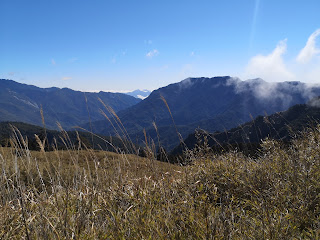上月首次到台灣旅遊,便有幸登上台灣百岳之一的合歡山東峰。
On my first trip to Taiwan last month, I had the luck to hike up
to one of the so-called 100 peaks of Taiwan, East Peak of Hehuanshan mountain.
本來是跟內子打算在合歡山上唯一的住宿松雪樓住上兩晚的,但被上山那天的天氣嚇怕了:雨整天不饒人的下,好不容易停了仍有一層濃霧縈繞,我倆心想這樣子待在山上是沒意思的,住一晚什麼都夠了。
Originally my wife and I wanted to stay for 2 nights at the only
lodge at Hehuanshan, but the weather wasn’t doing us a favour on our day of
arrival with relentless rain for almost the whole day and thick fog after the
rain finally stopped. We thought that there wasn’t much point staying in the
mountains with such weather and decided to check out the next day.
第二天一大早05:30起床想看日出,四周仍是濛瀧一片,待退房時霧終於有消退的跡象,作一次簡短的行山到下午才走還可以。霧散得很快,不一會便陽光普照,不只天色馬上明朗,連心情也頓然開朗了。
The next day I woke up at 05:30 for the sunrise that turned out
to be heavily shielded by the fog. There was finally some first sign of the fog
clearing by the time we completed the check-out, and we thought that we might
be able to go for a short ramble until the afternoon. The fog lifted
surprisingly quickly and lifted our spirits as blue skies and brilliant
sunshine finally took firm hold.
 |
| 被霧蔽的日出 A sunset shrouded by fog |
 |
| 霧剛開始散 First sign of fog lifting |
我們先走一小段小奇萊步道,沿途平坦易走,景色開揚,間中經過盛開的山杜鵑,為四周加添鮮艷的色彩。我們驚訝下了一天大雨後,碎石路竟不覺濕,難道高山的太陽特別厲害,把霧雨的水份和鬱悶瞬間一併曬掉嗎?
We first went on a short stretch of the Xiaoqilai Trail, which
was mostly flat with an open view. The wild rhododendron pseudochrysanthum
bushes in full bloom added vibrant colours to the ambience. We were surprised
that the ground felt totally dry even after the previous day’s downpour, and
wondered what magic power there was in the sun in sweeping away the damp and
gloom of the day before in no time.
 |
| 回望松雪樓 Looking back to our lodge |
然後我們跟着其他遊人到松雪樓的後山,踏入那漫山一片茂密的山杜鵑叢,但見人群在花叢中鑽來鑽去,一邊賞花一邊忙着找最佳位置和角度,擺出不同姿勢拍照,彷如搬了上山的台中花博,我可沒想過,海拔三千多米的高山也可變成一個燦爛的杜鵑花園!
We then followed other tourists to the slope behind the lodge.
It resembled a flower show lavishly decorated by rhododendrons, as the tourists
were busy finding the best spots and putting on the best poses for photos while
weaving through the sea of flowers. We never expected that flowering plants
would flourish in such abundance at greater than 3000 metres altitude!
有如花卉展的杜鵑叢 Wild rhododendrons putting on a flower show
 |
| 花叢中冒出來的金翼白眉 A laughing thrush emerging from the flowers |
 |
| 遊人如鯽 Rhododendrons popular with tourists |
告別了杜鵑,便要踏上登合歡東峰的征途。此路大致上挺陡峭,須緩緩拾級而上,幸好台階鋪設得好,而且攀得越高,越能看得清四周山峰的起伏,視野也更廣闊,每走上百步左右稍事歇息時環顧四方,讚嘆美景,疲勞很快便消失,可以繼續行程。
We bade farewell to the rhododendrons and set off on the trail
to the East Peak. It was a rather exhausting ascent, thankfully made easier by
sturdy wooden steps built along this steep trail. We were also rewarded by the
progressively more open views of the surrounding mountain ranges. We took our
time and paused every 100 steps or so to take in the picturesque views and
recover before resuming our slow walk up the steps.
一步步登天 Heading to the East Peak, one step at a time
 |
| 荒廢了的滑雪纜車站 A former ski lift station |
 |
| 半路的景觀 Panorama half-way up the East Peak |
往東峰的最後十分鐘,路途變得較平坦,很快便到了一個山崗,豎着一根木柱寫了「合歡山東峰海拔3421米」,在那山崗有數株長滿花蕾的杜鵑,剛巧有隻山上頗為常見的金翼白眉鳥在其他矮樹中飛躍,還跳到我伸手可及之處,讓我吃驚:野鳥怎麼會不怕人的?我也想,要是再過兩週左右,整個山崗杜鵑盛放,鳥兒又飛舞其中,會是個如何賞心悅目的畫面!
The last 10 minutes on the path to the East Peak became much
easier to negotiate, and we eventually reached a mound with a pole which marked
the peak and its altitude of 3421 metres. Near the pole there were a couple of
rhododendron shrubs studded with buds, and I caught sight of a Taiwan
white-whiskered laughing thrush dashing between the bushes of other plants. At
the closest the bird was actually within the reach of my arms, and I wondered
how wild birds were not afraid to come so close to humans. I could not help but
imagine how serene and scenic this place would become after another couple of
weeks, when the buds would fully blossom and birds dance between the flowers.
 |
| 含苞待放 Rhododendrons with buds |
 |
| 東峰標誌柱 The pole marking East Peak |
不怕人的金翼白眉鳥
The laughing thrush that is not shy of people
山崗環顧四周盡是好風景:台灣和東亞海拔最高公路合歡山公路、合歡山主峰、延綿至遠方的山巒,還有合歡山雲霞的「發源地」:自放晴的第一刻起,一直有一片連綿的雲霞纏繞着好些高峰,時厚時薄但揮之不去,從東峰的山崗剛好給我看到有個山谷,雲霞源源不斷冉冉升起,再隨風勢向不同方向擴散,偶爾直撲向東峰,令人頓然覺得有如墜入雲霧中。我讓雲霧帶着視線走到群山中不同的地方,全面感受合歡山披着雲彩的美,也給記憶和相機有充分時間帶走這一片片雲彩。
The panorama around the East Peak was varied and breathtaking,
including the main peak of Hehuanshan and mountain ranges further afield, the
highest highway of Taiwan and East Asia (Hehuanshan Highway, or Provincial
Route 14A), and the origin of the cloud and mist that continually decorated the
mountains of Hehuanshan. It was a valley which seems to churn out mist
continuously like a steam engine. Then the mist would rise up and spread in
different directions depending on the wind, and occasionally it would head
straight to the East Peak, giving us a sense of drifting into the heavens. I
let my eyes follow wherever the cloud and mist would glide so that I could
visually explore different parts of the Hehuanshan mountain range, allowed
myself to feel the magic of being surrounded and blanketed by this meandering
stream of whiteness, and gave myself sufficient time to register such surreal
scenes in my memory as well as in my camera.
 |
| 合歡山公路及一帶的山脈 Hehuanshan Highway and the mountain ranges nearby |
 |
| 東峰附近的景觀 Panorama near the East Peak |
 |
| 雲霞的發源地 The valley generating the cloud and fog surrounding Hehuanshan |
在山上六小時,第一次見識到三千四百多米的山巒,可以集叢花、飛鳥和雲彩於一地,令人大開眼界,換了其他地方,如此高海拔的地方要麼會是終年積雪,要麼就是不毛之地,豈會像合歡山般多采多姿?合歡山一行,徹底令我們對高山改觀,也是這個台灣旅程的一大驚喜。
My six hours in the mountains really changed my perception of
high-altitude landscape. I did not expect to see an abundance of flowers, birds
and clouds, in contrast to many places in the world where such altitude is
either inhospitable to life forms in general or would see a perennial cover of
snow. Who would have thought of a world colourful and bursting with life so
high up? This is one big pleasant surprise of this trip to Taiwan.










Comments